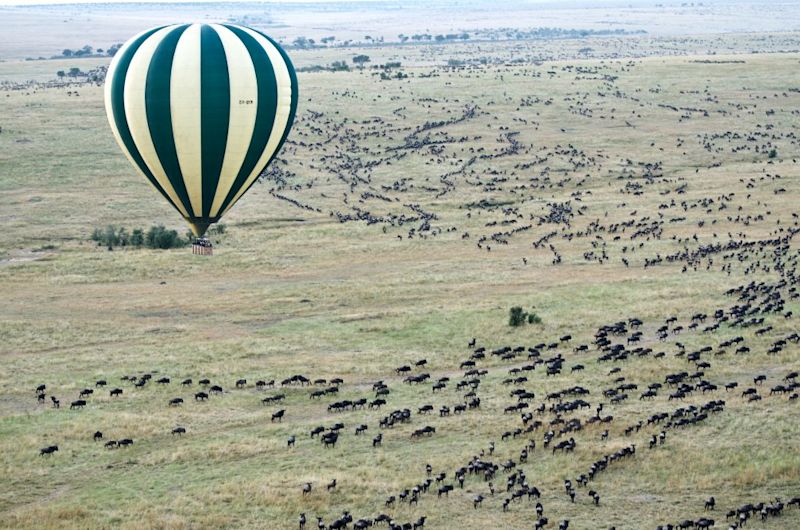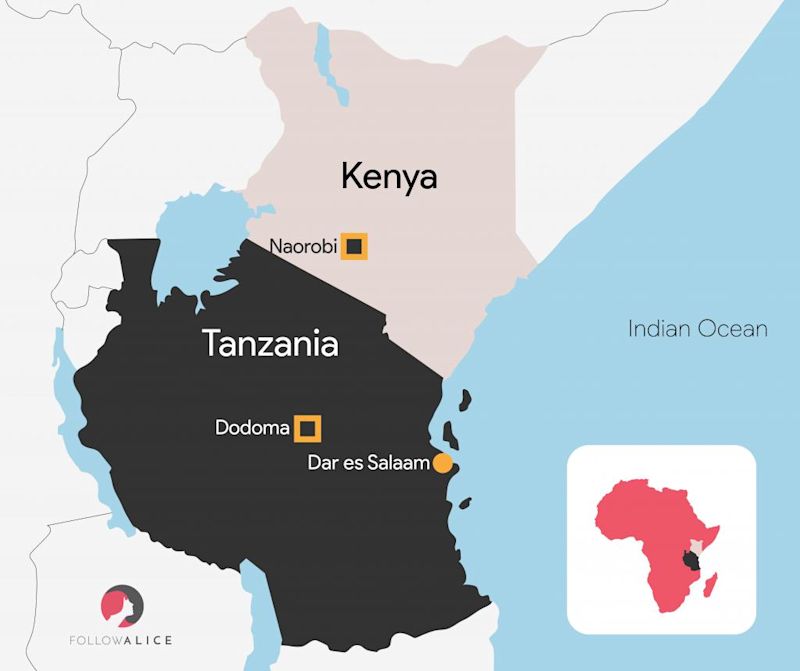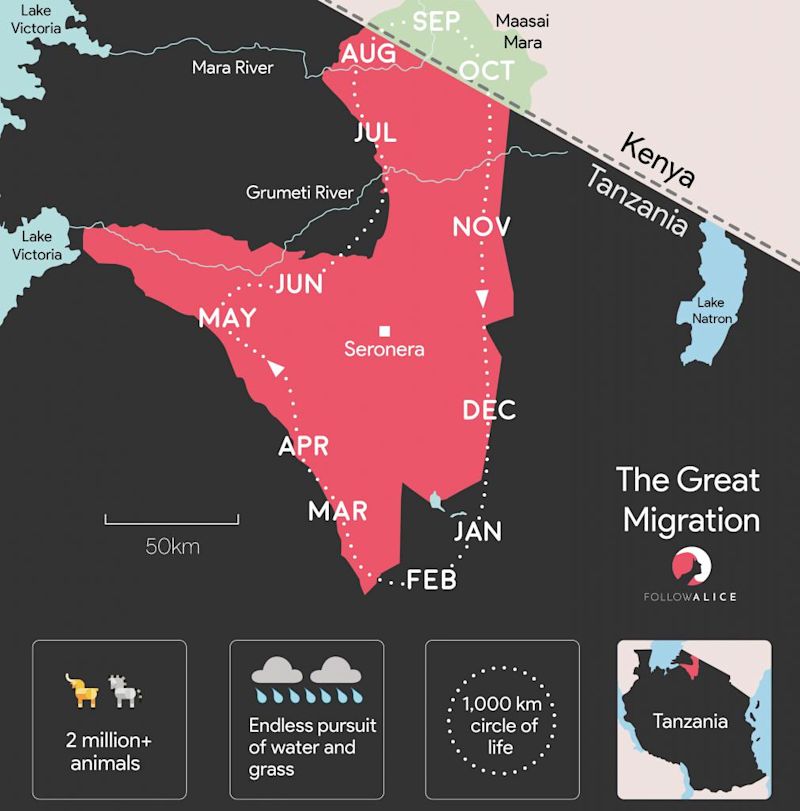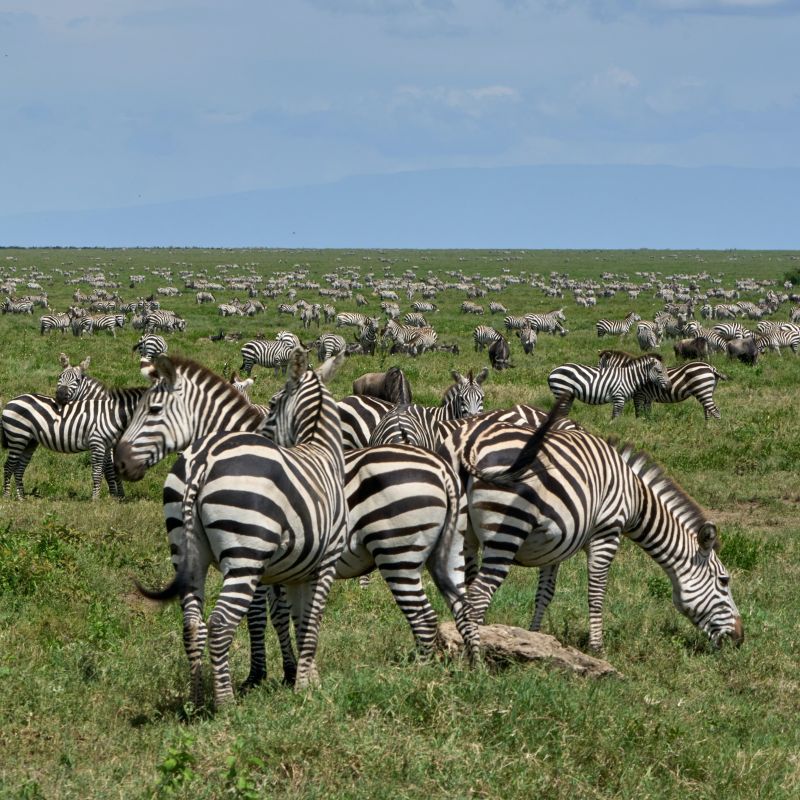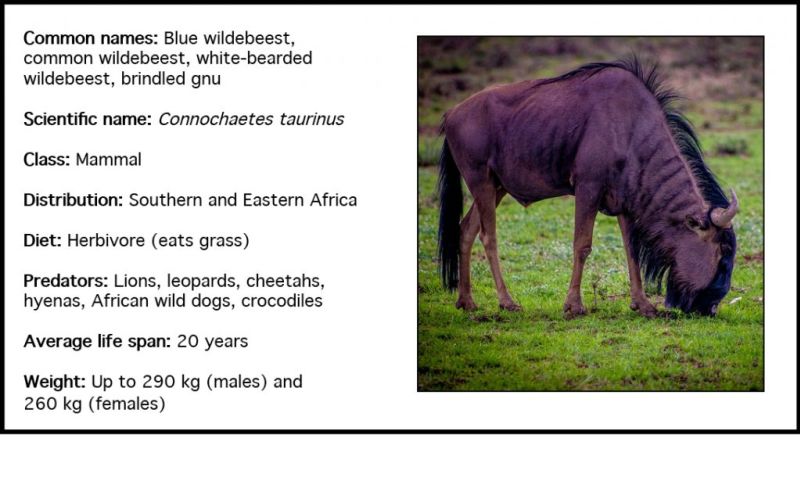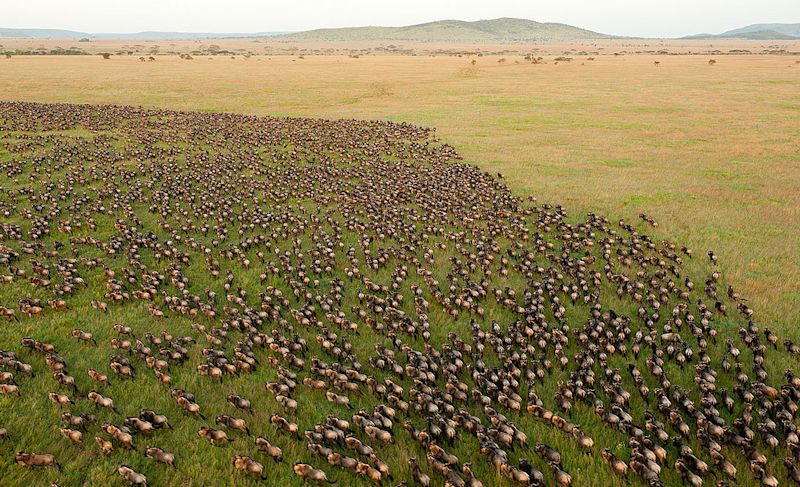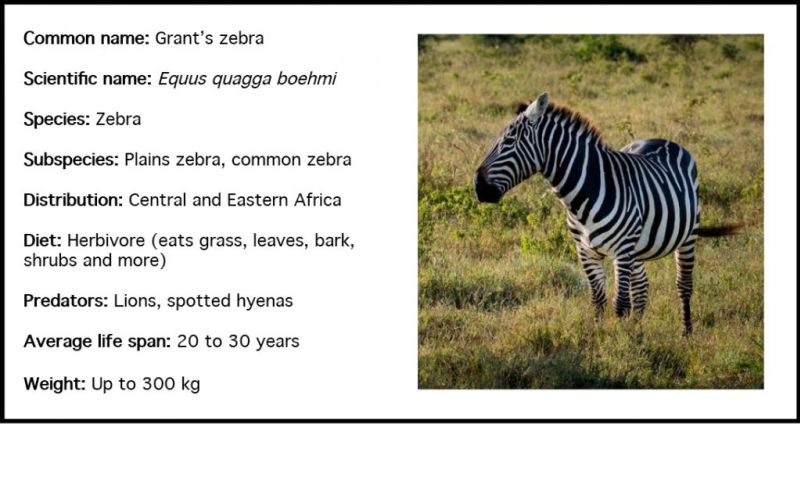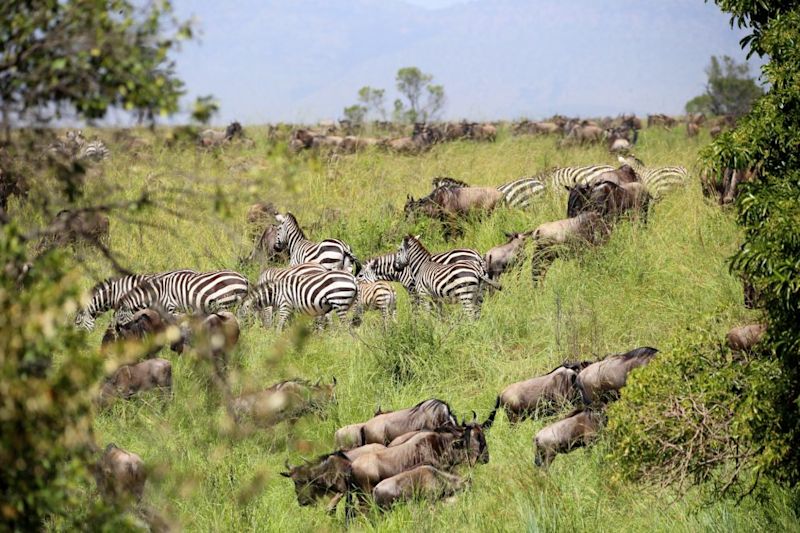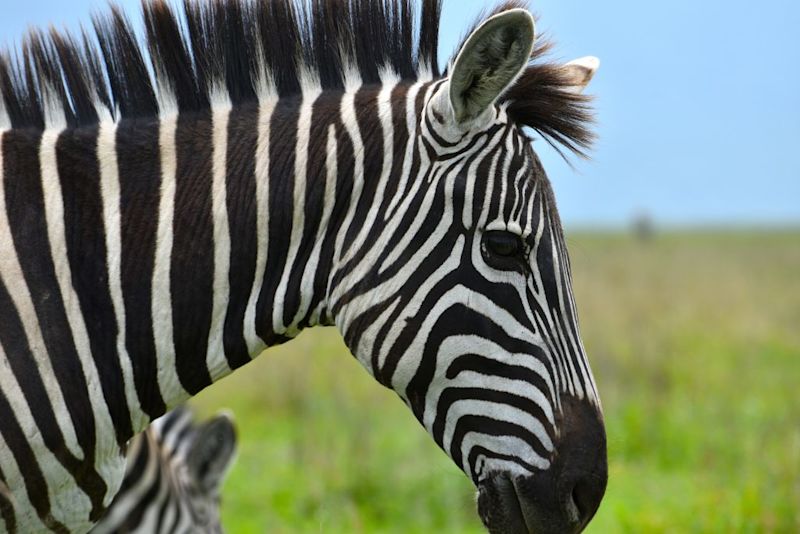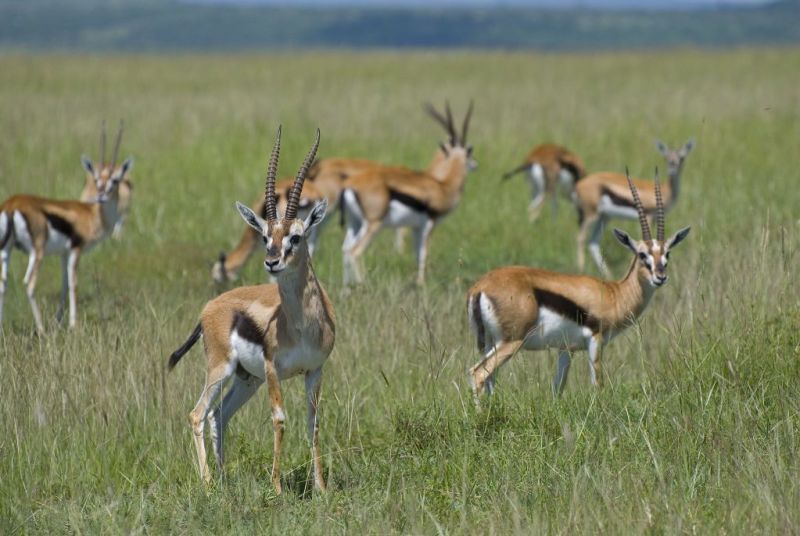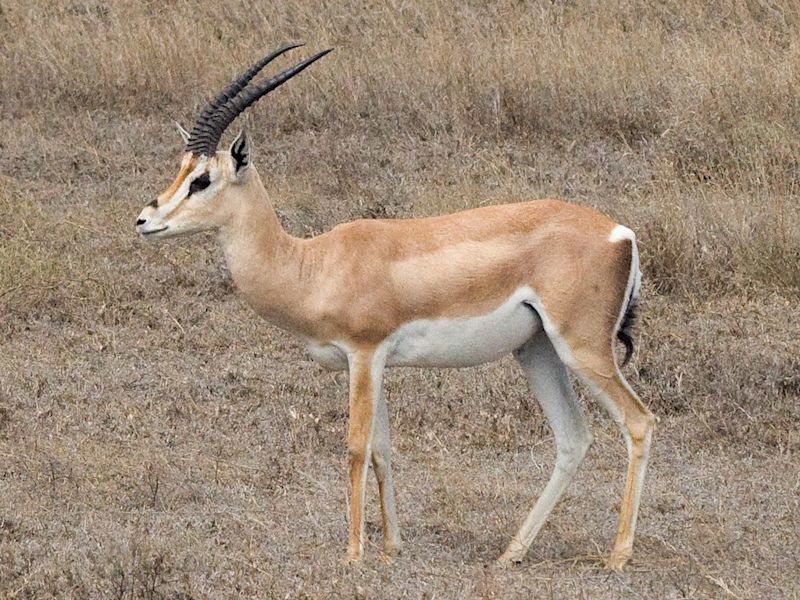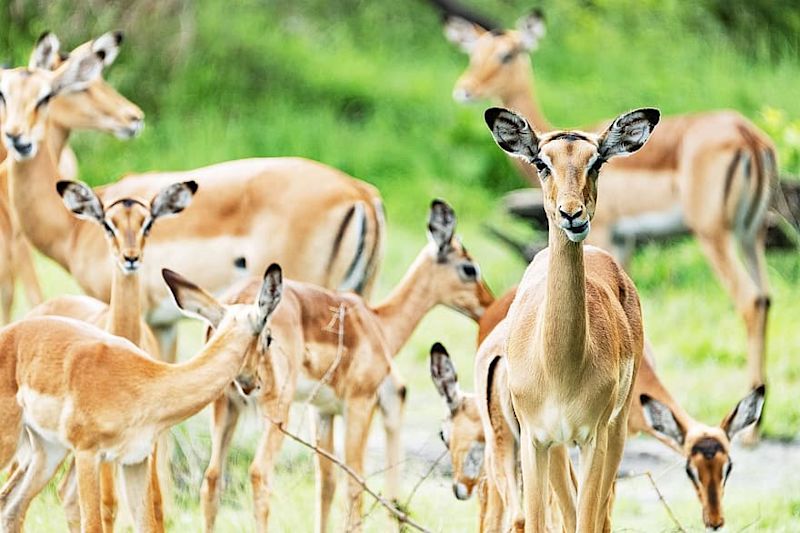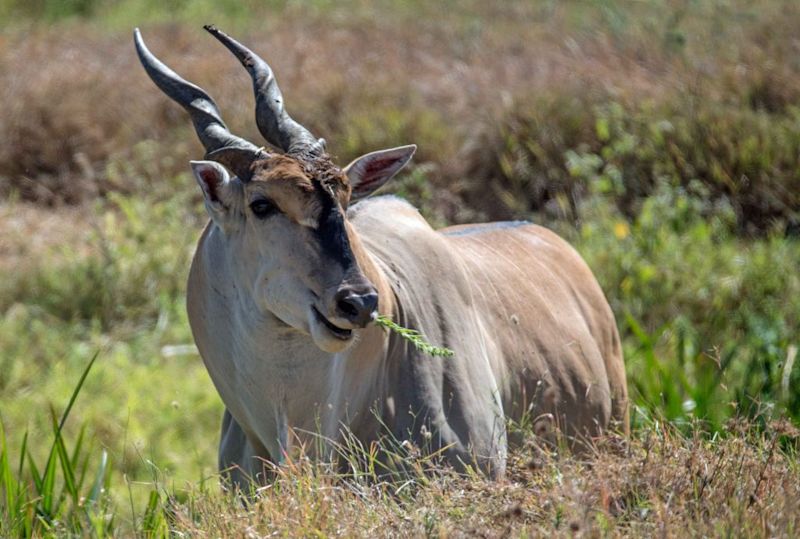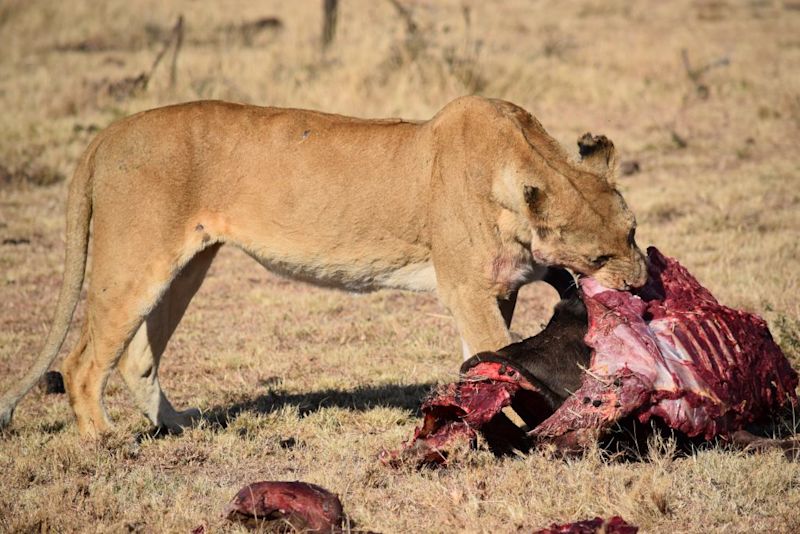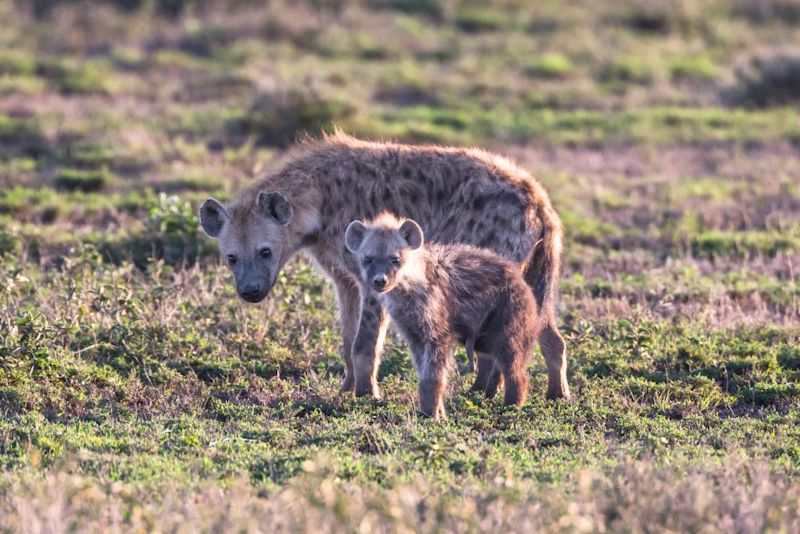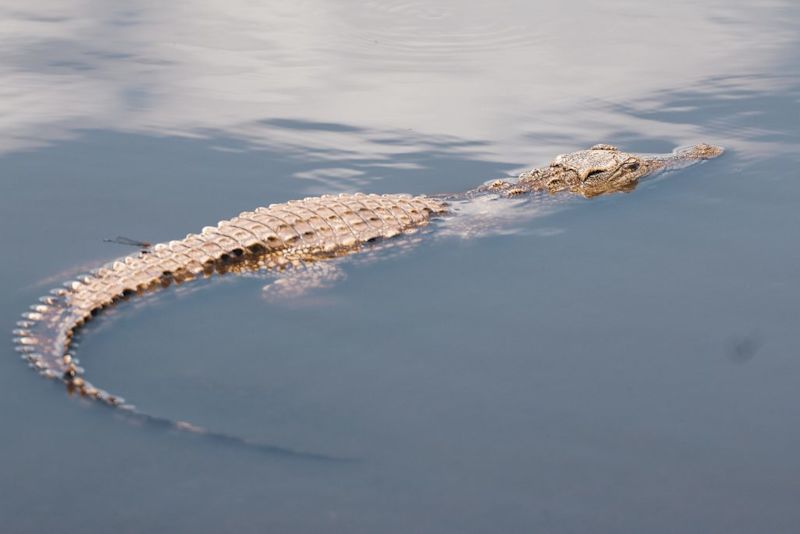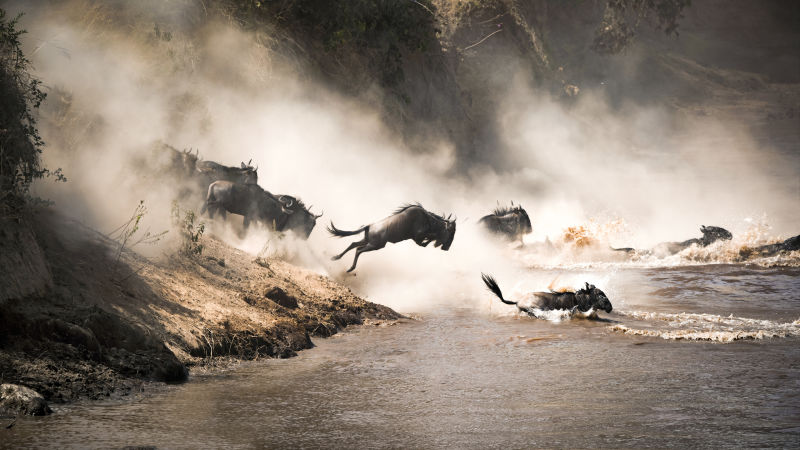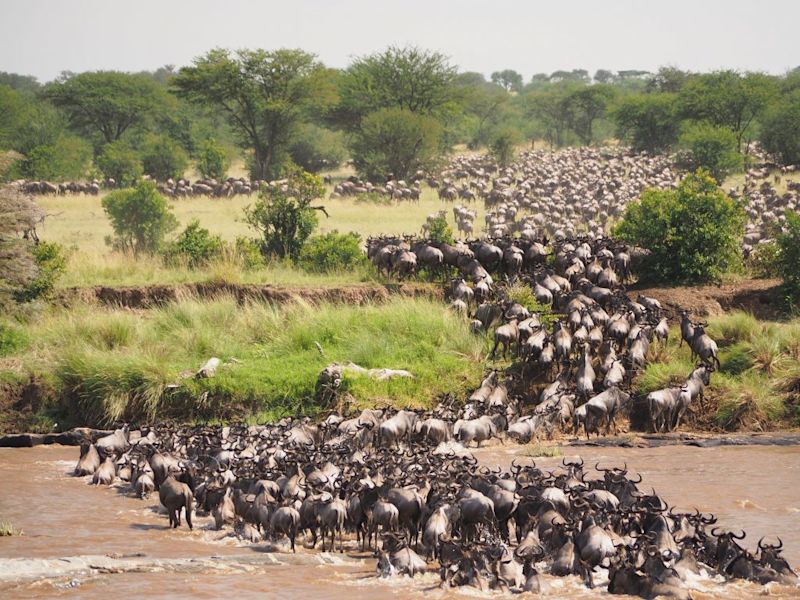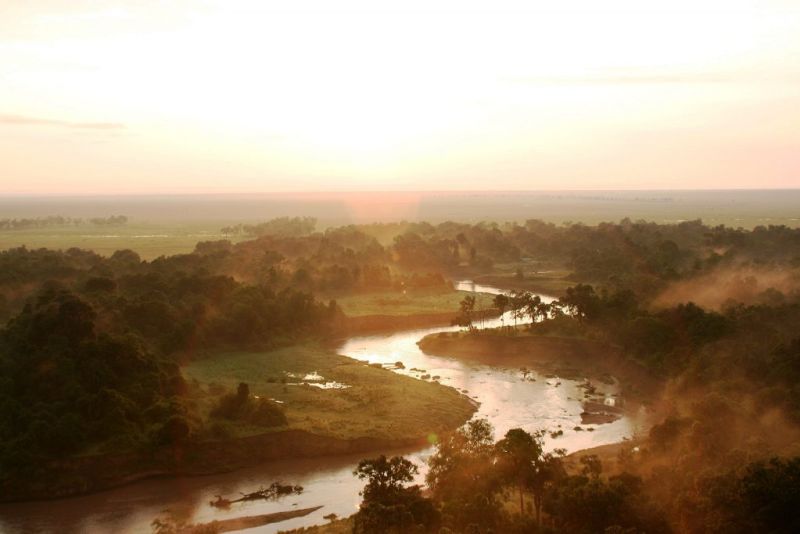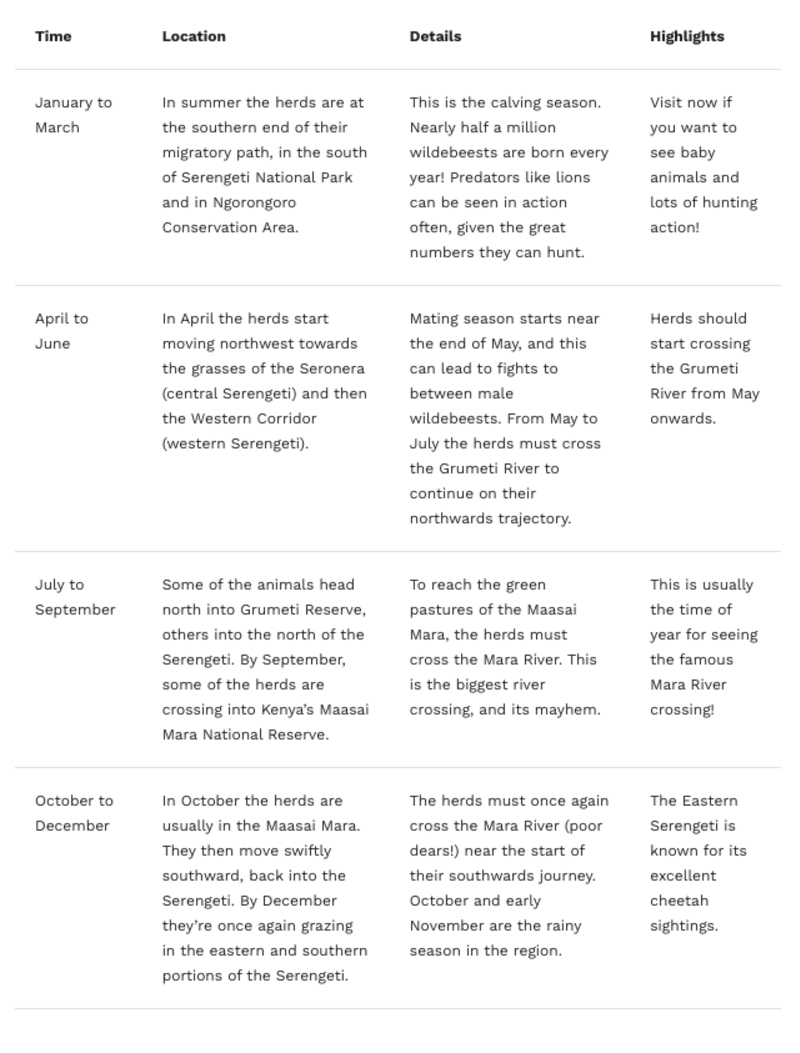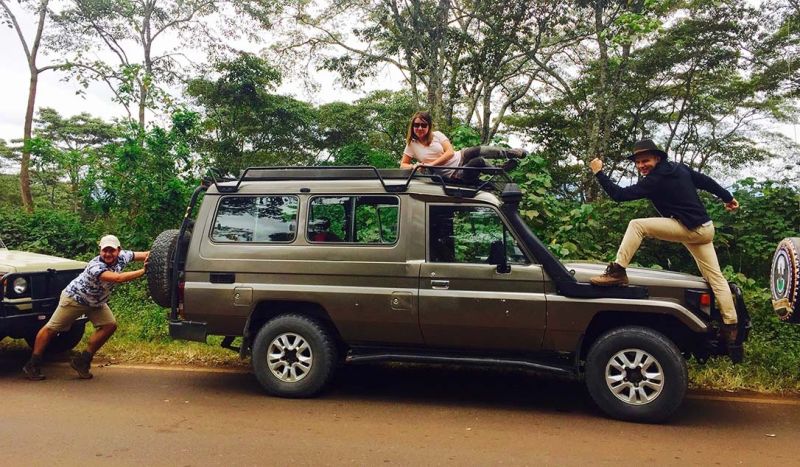What is the Great Wildlife Migration?
The Great Wildlife Migration – also simply called the Great Migration – is the largest overland migration on Earth. Around two million hoofed animals move together in a roughly circular path across a vast expanse of East Africa. An annual phenomenon, it's also a migration with a 'tail': predators like lions stalk the travelling herds for prey. It's a wildlife extravaganza that draws visitors from the around the world who are eager to go on safari and see this unique spectacle for themselves.
The Great Wildlife Migration is an enormous, cyclic migration in Eastern Africa of two million hoofed animals.
The Great Wildlife Migration is an astonishing sight, both from the ground and the air
Where can I see the Great Migration?
The Great Wildlife Migration takes place in northern Tanzania and southwestern Kenya. It's a cross-border ecosystem that the two countries collaborate in protecting. We love a good wildlife collaboration!
Map showing location of the Great Wildlife Migration in East Africa
Path and map of the Great Migration
There is no fixed Great Migration path. Rather, each year a unique path develops based on the availability of food and water. Each cycle can end up being anywhere between 800 and 1,600 km in length.
That said, there's a general pattern to the path followed by the Great Migration animals. The animals of the migration move in a clockwise direction through the length of the Serengeti National Park and up then up into the Maasai Mara National Reserve in Kenya. The route repeats each year and covers roughly a thousand miles.
Knowing the general route of the Great Wildlife Migration can help you to judge roughly when and where some of the herds will pass through. This is obviously useful when planning your African safari.
Map of the Great Migration
The map below gives an idea of the sort of path taken annually by the Great Migration animals.
Map showing the general sort of path followed by the Great Migration
As you may have noticed in the map above, the animals of the Great wildlife Migration often head further south than the Serengeti National Park. This is because they usually also migrate through the Ngorongoro Conservation Area, another superb protected area in northern Tanzania.
So while most of us think of the Great Migration as occurring in Serengeti National Park and Maasai Mara, it actually takes place in the following five protected areas:
- Serengeti National Park (Tanzania)
- Ngorongoro Conservation Area (Tanzania)
- Loliondo Game Controlled Area (Tanzania)
- Grumeti Reserve (Tanzania)
- Maasai Mara National reserve (Kenya)
Now you know. 😉
Zebras form an integral part of the Great Migration
What animals take part in the migration?
The Great Migration is a spectacle unlike any other on earth. Around two million animals move en masse across the landscape of the Serengeti and Maasai Mara. The bulk of the migrating mammals are wildebeests. But there are also incredible numbers of zebras and different antelopes taking part too. Here’s a quick look at each animal you can look forward to seeing in the Great Migration ...
1. Wildebeests
At the heart of the Great Wildlife Migration is the wildebeest, or the blue wildebeest to be more precise. This is so much the case that sometimes the migration is referred to as the Great Wildebeest Migration. Around 1.5 million wildebeests take part in the migration. What a number! The pageant they put on when moving en masse is unique and mesmerising.
Migratory herds
The 1.5 million blue wildebeests of the Great Migration don't all move in one astronomically large herd. There are various herds that separate, converge and morph as the migration moves forward. That said – and as the image below attempts to show – the herds are still massive, and are utterly uncountable to the dumbstruck spectator!
It's hard to comprehend their numbers without being there yourself
Given the endless migratory habits of the wildebeests, it may not surprise you to learn that calves can stand within seven minutes of being born, and can keep up with the herd after just a coupe of days! These are animals born to get a move on!
Around half a million wildebeests are born every year between January and March in the Serengeti.
2. Zebras
Around 200,000 zebras travel alongside the wildebeests as part of the Great Migration. These zebras are a subspecies of the plains zebra known as Grant's zebra. They're the smallest of the plains zebra, and very beautiful. The stripes on their body are vertical, while those on their legs are horizontal.
Migrating alongside wildebeests
Zebras are highly social animals, and live in herds. Fascinatingly, the reason that zebras can move in harmony with wildebeests in the Great Migration is that the two creatures eat different parts of the same type of grass. This is why (as shown in one of the photos below) you often see zebra and wildebeest herds mixing along the Great Migration route.
Zebras and wildebeests mingle peacefully | Image by J. Hunt
Did you know that female zebras have a gestation period of over a year? They can only carry one calf at a time, and, once the calf is born, they nurse it for up to a year.
Zebras and wildebeests make great travelling buddies because they eat different parts of the same grass.
A zebra up close
3. Antelopes
Various types of antelopes also make up part of the Great Wildlife Migration. Most notably, you have the following four antelopes making up the ranks of the migration:
- Thomson’s gazelle (Eudorcas thomsonii) – sometimes referred to as a “tommie”. Around 500,000 take part in the Great Wildlife Migration! They're easy to identify by the black stripes that run down the sides of their bodies. They're fantastic runners, and can exceed 65 km per hour.
Thomson's gazelles are the second most prominent animals in the Great Wildlife Migration after wildebeests
- Grant’s gazelle (Nanger granti) – it's similar to a Thomson's gazelle, but is much larger. It also lacks the black side stripes of the Thomson's gazelle, making the two easy to distinguish even in isolation. These guys can run as fast as 80 km per hour! An important skill when you have predators chasing you down your entire life.
A Grant's gazelle | Image by S. Nygaard
- Impala (Aepyceros melampus) – this slender antelope is a favourite with many for its beautiful appearance and graceful leaping. And boy can they run! Impalas can actually reach a run-in speed of 90 km per hour.
Impalas are among the antelopes that take part in the Great Wildlife Migration
- Common eland (Taurotragus oryx) – it can grow to be 1.6 m at shoulder height. Around 18,000 elands take part in the Great Wildlife Migration. Elands are the slowest antelope, running at only about 40 km per hour. They can, however, jump three metres into the air!
The eland – the largest antelope – is also a member the Great Migration
About half a million Thomson's gazelles take part in the Great Migration.
Animals that prey on the migration herds
Various animals prey on the herds of the Great Wildlife Migration. Think leopards, cheetahs and African wild dogs, for instance. But front and centre is the lion, the mighty King of the Jungle. Lions actually stalk the herds, moving across the landscape in pursuit of them. Another notable Great Migration predator is the hyena, which also tracks the herds, looking for chances to strike. Some predators don't stalk the migration, but take their opportunities when they come. Of significance here are the massive crocodiles of the Serengeti's rivers.
Here's a little more on each of these three fearsome predators ...
1. Lions
Around 3,000 African lions stalk the herds of the Great Migration. It's interesting to note that male lions generally hunt alone, while female lions (lionesses) hunt in a cooperative group.
Also interesting is the fact that wildebeests and lions both have the same maximum running speed: around 80 km per hour. Wildebeests can, however, sustain their running for longer. This is one of the reasons why cooperative hunting is useful to lions.
An adult lion's roar can be heard from 8 km away!
A lioness feasting on a wildebeest carcass
2. Hyenas
Hyenas are well known as scavengers. But what some don't realise is that they actually kill most of their prey. So what they really are is opportunists. And did you know that their bite is more powerful than that of lion??
Around 7,000 spotted hyenas stalk the Great Migration herds. They're able to do this as they're endowed with fantastic stamina – not all predators can keep up with the herds. Interestingly, female spotted hyenas are heavier on average than male hyenas. Specifically, female spotted hyenas grow to weigh 44 to 64 kg in comparison with male spotted hyenas, which weigh in at just 40 to 55 kg.
Given their spooky 'laughter', a clan of hyenas is also sometimes called a cackle of hyenas.
Hyena cubs may be adorable, but they're fearsome aggressors from the day they're born
3. Crocodiles
Nile crocodiles attack wildebeests and other animals during the river crossings of the Great Migration. This is part of what makes the crossings so very dangerous for the migrating herds. These crocodiles are enormous, sometimes measuring 5 m (17 ft) in length. Shudder. The can also grow as old as 70 years!
Nile crocodiles prey on the Great Migration herds during their river crossings
Dangers of the Great Migration
Of the roughly 1.5 million wildebeests of the Great Wildlife Migration, about 250,000 die every year. That means around a sixth of the wildebeest population doesn't survive the Great Migration. The causes of death of vary, and include being killed by predators, dying of thirst or starvation, and being drowned when crossing large rivers.
River crossings of the Great Migration
The wildebeests, zebras and antelopes of the Great Migration must cross many streams and rivers in their search for water and green pasture. The larger river crossings are particularly dangerous moments for them.
Most significantly, the animals must cross the large, crocodile-infested Grumeti and Mara Rivers of the Serengeti. Sensing the danger, the herds cross the rivers in a stampede. Some of the animals are taken out by crocs, others are trampled to death, and still others are swept away by the current and drowned.
The frenzy and chaos of these dramatic crossings draw many fascinated safari-goers to the Mara and Grumeti Rivers of the Serengeti.
Wildebeests cross big rivers quickly to try avoid becoming croc kill
It's also interesting to note that the carcasses of the animals not surviving the infamous Mara and Grumeti River crossings play an important part in the ecosystems of the latter. Scavengers feast on the dead animals, and the rivers receive vital nutrients from the decaying bodies. In fact, National Geographic claims that each year the ecosystems of the Serengeti's rivers receive two million pounds of rotting wildebeest flesh!
River crossings are very dangerous for the herds of the Great Migration, but thirst and hunger are, in fact, the bigger baddies.
A herd of wildebeests crossing the Mara River in Serengeti National Park
Which is better: Maasai Mara or Serengeti?
There are two places you can visit to see the Great Wildlife Migration: Maasai Mara National Reserve in Kenya and Serengeti National Park in Tanzania. Both are phenomenal parks where you can enjoy epic safaris. There are, however, distinct pros to each destination, as we discuss in Kenya vs Tanzania: which offers the better African safari?
At Follow Alice we feel that the Serengeti is the better safari destination, especially when it comes to viewing the Great Migration. Our reasons are:
- A far larger percentage of the Great Migration takes place in Tanzania.
- The spectacular river crossings take place in Tanzania, not Kenya.
- Tanzania is the safer country.
The beautiful Serengeti | Image by S. Swanepoel
What is the best time to see the migration?
The Great Wildlife Migration follows a different route each year, depending on the availability of water and grass. There's a pattern, however, to the animals' movements, as indicated in broad strokes in the table below.
June to September are the best months for seeing the river crossings of the Great Migration. For these, you must visit the northern Serengeti.
Note: If you'd like to plan a safari based on a specific aspect of the Great Migration, we invite you to chat with us so we can advise you on exactly when and where to travel.
We all want to see the Great Migration (and the crazy tourists!)
Is it time to get your safari on??
Chat to us about which aspect of the Great Migration you'd most like to see, and we'll advise you on when and where to plan your African safari!
Let's chat Great Migration!



